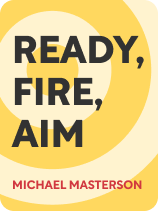

This article is an excerpt from the Shortform book guide to "Ready, Fire, Aim" by Michael Masterson. Shortform has the world's best summaries and analyses of books you should be reading.
Like this article? Sign up for a free trial here.
What should be your top priority during the first stage of your business? What are some effective ways of coming up with new product ideas? How can you keep your business growing after initial success?
In Ready, Fire, Aim, Michael Masterson presents a strategy for building and growing a profitable business. He says successful, multimillion-dollar businesses progress through four stages of development, each presenting different challenges and objectives that entrepreneurs must prioritize.
Read more for an overview of this book that can help you ensure continued growth and profitability for your business.
Overview of Ready, Fire, Aim by Michael Masterson
In Ready, Fire, Aim, Michael Masterson (a veteran entrepreneur, multimillionaire, and best-selling author) details four stages of business development—launch, expand, optimize, and sustain. We explore each one and walk you through Masterson’s strategy for successfully navigating them.
- Stage 1: Launch explains how to align your first product or service with what customers want and effectively market it.
- Stage 2: Expand explores how to generate ideas for additional products and services that increase your earning potential.
- Stage 3: Optimize covers how to structure your management team to handle business operations effectively.
- Stage 4: Sustain presents three tactics for driving long-term growth and profitability.
(Shortform note: Masterson uses wordplay in the book title—changing the phrase, “ready, aim, fire” to “ready, fire, aim”—to underscore a critical principle: First launching and marketing an imperfect product (“fire”) and then incorporating feedback (“aim”) can generate more sales than perfecting a product before launching it. In Stage 1, we’ll expand on how promoting your product before perfecting it can increase your chances of success.)
Stage 1: Launch
During the first stage of business development, your priority is to successfully launch a single product or service into the market. During this stage, you put multiple versions of your offer on the market, all the while using trial and error to test and refine what it is and how you present it. In other words, rather than focusing your resources on perfecting your product or service before you launch it, you’ll focus your resources on testing and optimizing your marketing strategy. Masterson explains that de-prioritizing the perfection of your product or service and prioritizing its marketing improves your chances of long-term success in four ways. It enables you to:
- Lower your overhead costs by helping you test your assumptions about how profitable your product or service will be before you invest significant time and resources in its development.
- Create a more valuable product or service by helping you collect feedback on how to make it more appealing to potential customers.
- Improve customer engagement by helping you learn about which marketing and sales strategies resonate with your target market.
- Fund the ongoing growth of your business by helping you acquire a customer base and generate sales.
Masterson suggests a four-step strategy to effectively market your first product or service:
- Determine how you’ll reach potential customers.
- Align your product or service with what potential customers want.
- Create marketing copy.
- Test different marketing strategies.
Let’s explore each step.
Step #1: Determine How You’ll Reach Potential Customers
The first step toward marketing your product or service is to determine how you’ll reach potential customers. Masterson suggests that the easiest way to figure this out is to research how established businesses in your industry advertise their offerings. This involves identifying the most successful businesses in your industry, finding out what products or services they advertise, and where and how often they advertise their offerings.
Step #2: Align Your Product or Service With What Potential Customers Want
Once you’ve determined how to reach your target market, the next step is to align your product or service with what potential customers want. Masterson states that it’s impossible to know whether your offer will be successful until you attempt to sell it. Therefore, you should prepare to create and market multiple variations of your offer before you commit resources to develop it.
He suggests the following process to come up with potential products or services:
1) Refer to the best-selling products or services from other businesses that you identified in Step #1 and pick one that resembles the offer you have in mind.
2) Consider all of the ways you can improve upon the existing best-selling product or service.
3) Create prototypes for the most promising variations that you come up with.
Step #3: Create Marketing Copy
Now that you have a few variations of your product or service, create some marketing copy for each one. Masterson suggests a four-part process for creating effective marketing copy:
1) List all of the ways your business is unique, noting how your business is better than others in your industry.
2) Pick one of your potential products or services and list all of the ways it will benefit customers.
3) Choose one unique business quality and one product or service benefit from the above lists that you think will appeal most to potential customers. Create marketing copy that emphasizes exactly why customers should care about these two points.
4) Provide testimonials or endorsements to prove your claims.
Step #4: Test Different Marketing Strategies
Now that you know how to create marketing copy, test different marketing strategies for each of your product or service variations. This involves experimenting with different ways to advertise each of your potential offers.
According to Masterson, this testing process will reveal two important insights:
- The product or service variation that’s generating the most interest and sales—in other words, the offer you should commit your resources to develop.
- The most cost-effective way to acquire customers, generate sales, and increase your profits.
To complete this step, Masterson suggests creating at least two versions of marketing copy for each product or service variation. Next, experiment with placing your advertisements in different marketing channels (your list from Step 1). Track your costs and results for each experiment to determine your most profitable product or service variation, as well as the most lucrative method for reaching potential customers in your market.
Stage 2: Expand
Once you’ve pinned down your marketing strategy, determined which product or service version appeals most to customers, and successfully generated sales for this offer, you’ll be ready to expand your business and your earning potential. Achieve this by focusing your resources on creating a broader range of offers—targeting your existing market, new markets, or both—and marketing them to both existing and new customers. Masterson explains that this strategy improves your chances of long-term success by:
- Helping you acquire new customers across different markets
- Providing new opportunities for you to profit from your existing customers
- Generating more sales, increasing your profits, and providing a steady stream of income to fund the ongoing growth of your business
In addition to improving upon best-selling products and services in your industry, Masterson suggests three methods to generate ideas for offers that appeal to both existing and new customers:
- Leverage your expertise and resources.
- Take advantage of emerging technologies or market trends.
- Focus on supplementary offerings.
Let’s explore each of these methods in detail.
Method #1: Leverage Your Expertise and Resources
Masterson’s first method for generating ideas for new products or services is to leverage your expertise and resources. This involves drawing upon your existing knowledge, the tools and technologies you have access to, and the networks you’ve established to brainstorm and identify offers that are uniquely tailored to your strengths.
Method #2: Take Advantage of Emerging Technologies or Market Trends
Masterson’s second method for generating ideas for new products or services is to take advantage of emerging technologies or market trends. This involves actively monitoring the latest developments in your industry and brainstorming innovative ways to capitalize on them.
Method #3: Focus on Supplementary Offerings
Masterson’s third method for generating ideas for new products or services is to focus on supplementary offerings. This involves brainstorming add-ons and accessories that provide additional functionality or benefits that enhance the overall value of a core product or service.
Stage 3: Optimize
Once you’ve expanded your product lines and increased your profits, optimize your internal systems and procedures. Achieve this by structuring your management team to handle day-to-day business operations. Masterson explains that this strategy improves your chances of long-term success by ensuring that all business functions run efficiently without your direct attention. This reduces costs and increases productivity and profits. It also allows you to focus on pursuing opportunities that fuel the ongoing growth of your business.
Structure Your Management Team
Masterson suggests that you follow five steps to structure your management team:
1) Outline all of the tasks involved in running your business and note the departments and managers who are accountable for them.
2) Group the tasks into operational functions and marketing functions.
3) Assign an overseeing manager to handle all operational functions, who will report directly to you.
4) Appoint separate overseeing managers for each of your product or service lines. They’ll report directly to you. They should assign their own marketing managers, sales managers, and product development managers.
5) Set key objectives for each overseeing manager and request regular progress reports.
Stage 4: Sustain
When you’ve structured your management team to handle operations, sustain your business’s long-term growth and profitability. Achieve this by relinquishing your role as CEO and instead acting as an adviser or investor for your business. Masterson explains that this strategy improves your chances of long-term success by enabling you to focus on high-level tactics that drive the continued growth of your business.
Masterson suggests three tactics to consider:
- Build strategic partnerships.
- Acquire other businesses.
- Go public.
Let’s explore how each of these tactics can help drive the growth of your business.
Tactic #1: Build Strategic Partnerships
Masterson’s first tactic, to build strategic partnerships, involves forming alliances with other businesses to achieve mutual benefits. This tactic can drive the growth of your business by helping you increase your market share, access resources, share costs, or reduce risk.
Tactic #2: Acquire Other Businesses
Masterson’s second tactic, to acquire other businesses, involves purchasing or merging with other companies to extend capabilities. This tactic can drive the growth of your business by helping you expand your product or service offerings, diversify your revenue streams, access new technologies or intellectual property, or secure talented employees.
Tactic #3: Go Public
Masterson’s third tactic, going public, involves selling shares of the company to raise funds. This tactic can drive the growth of your business by providing access to a large pool of capital that you can use to fund research and development, expand operations, or pursue new business opportunities. Additionally, it can increase your visibility and credibility in the market, which helps attract new customers, suppliers, and strategic partners.

———End of Preview———
Like what you just read? Read the rest of the world's best book summary and analysis of Michael Masterson's "Ready, Fire, Aim" at Shortform.
Here's what you'll find in our full Ready, Fire, Aim summary:
- The four stages of development every successful business goes through
- How to structure your management team to handle business operations
- How to effectively market your first product or service






